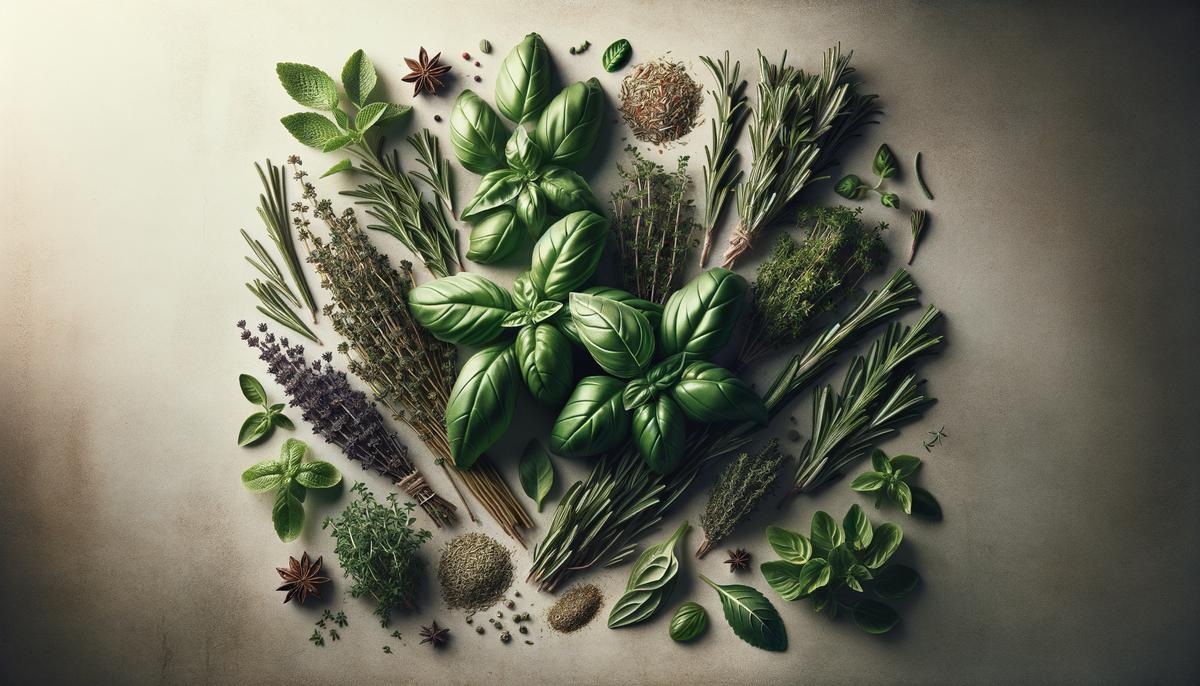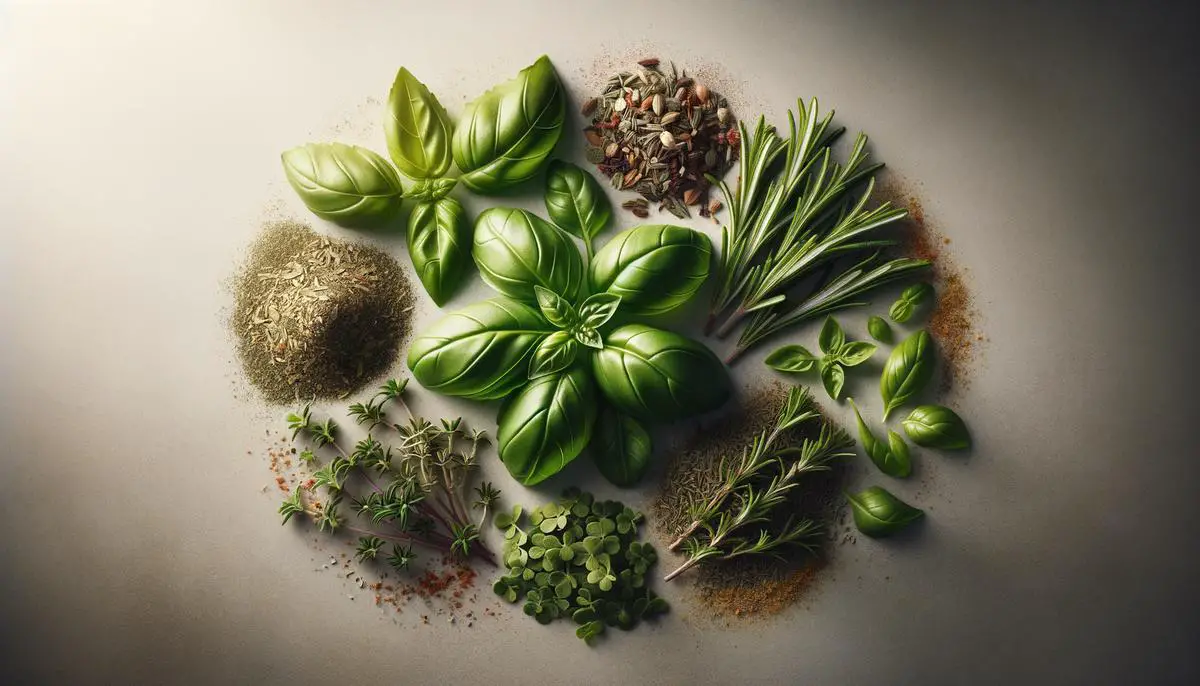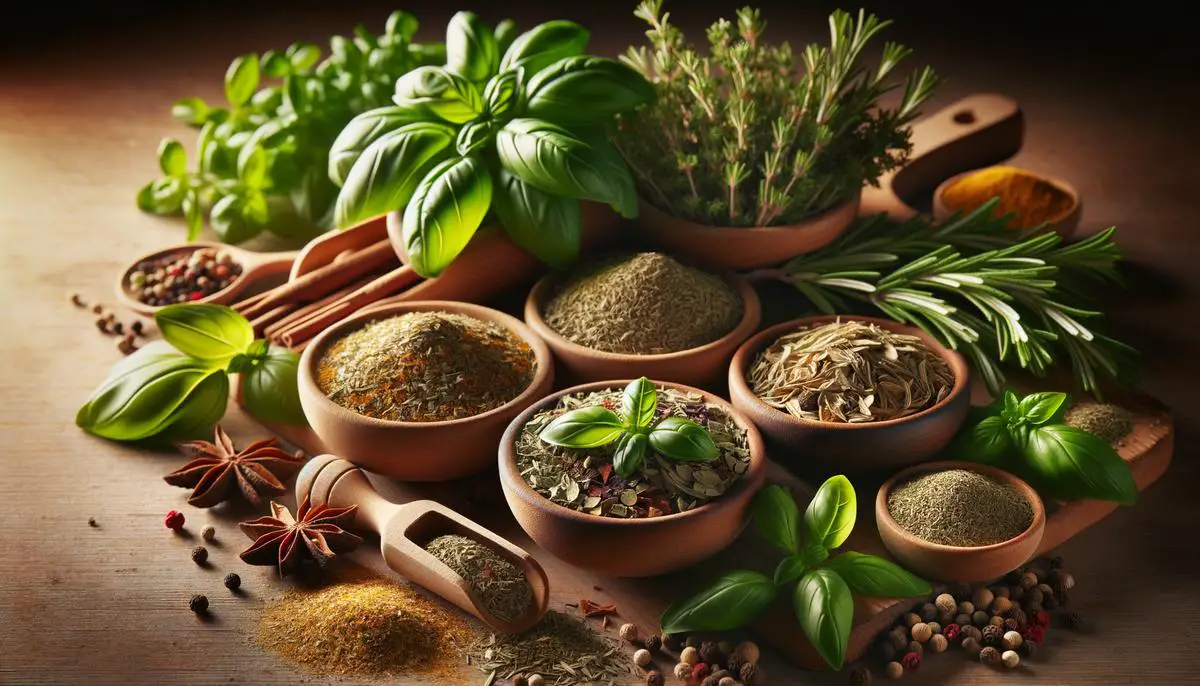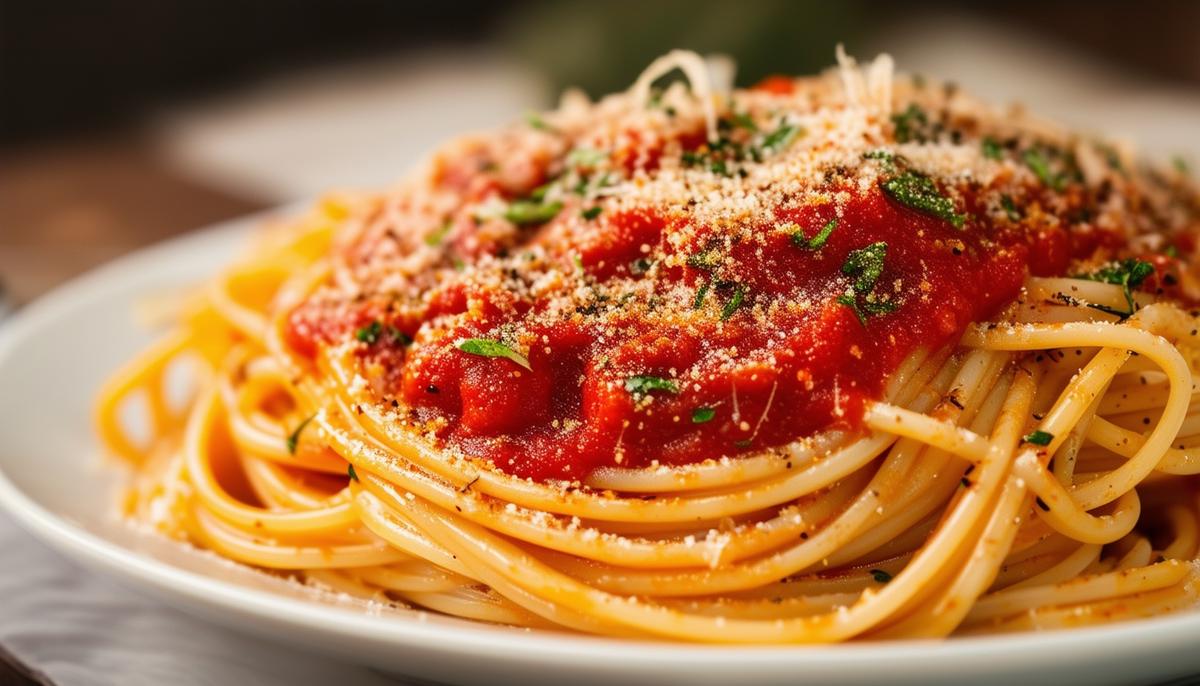
Components of Italian Seasoning
Italian Seasoning, a quintessential blend that imparts the essence of the Mediterranean into countless dishes, leans heavily on herbs like basil, oregano, and rosemary, each bringing their robust characteristics to the table.
Basil, with its sweet, fragrant profile, evokes the freshness of summer gardens, acting as a bright counterpart to more savory flavors. Oregano offers earthy, grassy nuances, often referred to as the backbone of this seasoning mix due to its boldness and versatility across Italian and Mediterranean cuisine. It resonates particularly well in tomato-based recipes, infusing them with a distinctly zesty punch.1 Rosemary, with its needle-like leaves and woodsy aroma, introduces a touch of evergreen zest, which complements roasted and grilled preparations by embedding a hint of herbal smokiness.
Thyme is another key player within this herbaceous congregation. Its subtle minty quality enhances complexity without overwhelming the senses. Thyme beautifully balances slow-cooked dishes, where it mingles over time to softly reveal its essence. Meanwhile, marjoram, often overlooked, is milder than oregano but carries a balsamic sweetness that rounds out the sharpness of other herbs.
For a spicy variation, some opt to incorporate red pepper flakes into the Italian seasoning mix. These flakes introduce a burst of heat, making the seasoning dance on the palate, an especially favored addition for those who enjoy a bit of spice.
Cooks seeking an add-on of aromatic sharpness might include garlic powder, which subtly but meaningfully incorporates garlic's flavor into the mix. Among optional yet periodically adored additions is sage, with its peppery-green fragrance which also pairs well with fatty dishes like sausages or poultry, guiding their heaviness towards a digestive harmony.2
Whether mixed into a dressing paired with olive oil and balsamic vinegar, or sprinkled over a rustic pizza, each pinch of Italian seasoning contributes a note to what might otherwise be an ordinary bite. The artful amalgamation of different herbs ensures a symphony of flavors, enhancing everything from classic marinara sauces to a simple grilled vegetable melody.
These components collectively imbue dishes with layers of flavor, going beyond the sum of their parts to offer a taste of Italian gastronomy, no matter where one's kitchen lies. Whether grounding roasted meats or sharpening the profiles of soups and stews, Italian seasoning proves to be an indispensable ally in the kitchen. Such is the power of well-chosen herbs; like instruments in an orchestra, each one plays its part to engage the senses, proving that sometimes, the simplest ingredients create the most delightful results in culinary arts.

Making Homemade Italian Seasoning
To craft your own Italian seasoning blend, the step-by-step process is an art and a science, fine-tuned with a perspective that cherishes customization. The process begins by sourcing quality herbs, which is vital for ensuring that the blend's aromatic characteristics are vivid. Look for freshness in packaging and vividness in color. Preferably, procure organic herbs from trusted vendors to assure their purity and potency.
- Gather Your Ingredients:
Get all your required spices together. Typically, for a basic homemade Italian seasoning, you will need:
- 4 tablespoons dried basil
- 4 tablespoons dried oregano
- 2 tablespoons dried rosemary
- 2 tablespoons dried thyme
- 2 tablespoons dried marjoram
If desired for heat, consider a teaspoon or more of red pepper flakes, and for added depth, perhaps a tablespoon of garlic powder.
- Grinding (Optional):
This step is optional but beneficial for unlocking more flavor. Some people prefer their seasoning slightly ground—not powdered but crushed just enough to meld flavors while retaining a textured consistency. A spice grinder or a pestle and mortar works well for this task. Grind according to personal preference; either a coarse grind for robust texture or slightly finer to integrate well into smoother sauces.
- Mixing the Spices:
Combine the herbs in a clean, dry bowl. Stir them together with a fork or a small whisk, ensuring the distribution is even. This homogeneity ensures that every pinch of your seasoning offers a complete taste profile.
- Customization:
Trust your palate. Personalizing the seasoning mix is not only satisfying but also crafts a blend that is uniquely yours. After combining your basic mix, you might want to adjust. Perhaps add more rosemary for a woodland hint or a bit more oregano for robustness. Making adjustments based on your cooking style and preference will further individualize your seasoning blend.
- Storage:
Store the mixed seasoning in an airtight glass jar. Keep this jar in a cool, dry place out of direct sunlight. Kitchen cabinets often provide an ideal balance of conditions.
The freshness and the potency of the herbs are paramount; typically, a well-prepared blend retains peak flavor for up to six months. Over time, the intense profiles of each herb will gradually wane. Making relatively small batches depending on usage frequency can mitigate this decline, maintaining freshness as you cook from season to season.
Remember, each ingredient evokes a journey through Italian gastronomy, transforming the mundane into meals enveloped in an evocative flavor narrative. The correct symphony of herbs enhances the dish in question and enriches the cultural fabric it carries—a tiny sprinkle, a meaningful journey from past to present at your table.

Culinary Applications of Italian Seasoning
Italian seasoning, with its harmonious concert of herbs, transcends mere infusion; it becomes a culinary staple adaptable across a spectrum of recipes that promise to elevate the home cooking experience. This blend, known for its aromatic and hearty herbal notes, seamlessly marries with various ingredients, bringing a whisper of the Italian countryside to each dish it graces.
In the realm of pastas and sauces, Italian seasoning infuses an ordinary marinara or Bolognese sauce with layers of depth, transforming it from standard to sublime. A teaspoon stirred into the sauce while it simmers permeates the entire dish with its aromatic essence and ties together the flavors of other ingredients like tomatoes, onions, and garlic.
Proteins such as chicken, beef, or fish also welcome Italian seasoning. For chicken, a dry rub composed of this seasoning blend, salt, and a touch of olive oil creates an enchanting crust, subtle yet satisfying, when grilled or roasted. In the case of fish like salmon or tilapia, sprinkling some seasoning before broiling imparts a light, agreeable quality that does not overpower the inherent flavors of the fish.3
Vegetable dishes gain a revivifying touch from this herbal ensemble. Whether it's roasted Mediterranean vegetables such as zucchini, bell peppers, and eggplant or simply sautéed green beans, a dash of Italian seasoning can synchronize with the natural flavors of the vegetables to enhance their taste without dominating.
The versatility stretches to bread dips and oils. Mix the seasoning into a high-quality extra virgin olive oil and you've crafted a delightful bread dip that evokes rustic Italy. To uplift the spirits of a dinner table, small bowls filled with this aromatic oil can be transformed into convivial focal points around which friends and family gather to share bread and stories alike.
Even breads themselves, particularly focaccia or pizza doughs, can incorporate Italian seasoning to permeate through each bite with its distinct Mediterranean accents. Kneading a tablespoon or so into the dough before its first rise infuses each nook and cranny with the dance of herbs, ideal for enlivening anything it partners with on the plate.
For a breakfast crossover, whisk a pinch into scrambled eggs or omelets. Here the seasoning gently incorporates through the dish, bringing an unexpected yet thoroughly enjoyable nuance to the first meal of the day. Similarly integrating it into potato hashes can craft a breakfast that speaks to both hearty fulfillment and culinary inspiration.
To take creativity further, one can explore including Italian seasoning in butter or cheese spreads, thereby granting a delicate lift to appetizers or canapés. An Italian herb-infused butter on a warm baguette slice brings a touch of luxe to any side dish or starter plate.
Throughout these applications, Italian seasoning stands as more than just a flavor enhancement; it's a passport to an artful culinary exploration, inviting chefs and home cooks alike to experiment with a potpourri of dishes that celebrate both tradition and imagination. Each inclusion welcomes a part of Italy into homes far and wide, proving that great seasoning is indeed the cornerstone of memorable cooking.

- Singletary K. Oregano: overview of the literature on health benefits. Nutr Today. 2010;45(3):129-138.
- Hamidpour R, Hamidpour S, Hamidpour M, Shahlari M. Chemistry, pharmacology, and medicinal property of sage (salvia) to prevent and cure illnesses such as obesity, diabetes, depression, dementia, lupus, autism, heart disease, and cancer. J Tradit Complement Med. 2014;4(2):82-88.
- Milde J, Elstner EF, Graßmann J. Synergistic effects of phenolics and carotenoids on human low-density lipoprotein oxidation. Mol Nutr Food Res. 2007;51(8):956-961.



